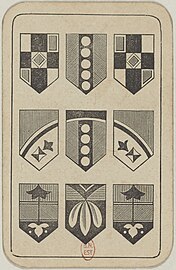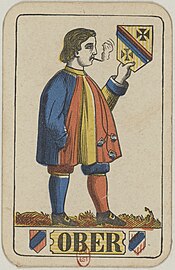| Shields | |
|---|---|
 | |
| Native name | German: Schilten |
| Deck | Swiss-suited playing cards |
| Invented | 15th century |
Shields (German: Schilten), also called Escutcheons, is one of the four playing card suits in a deck of Swiss-suited playing cards. This suit was invented in 15th century German speaking lands and is a survivor from a large pool of experimental suit signs created to replace the Latin suits. One example from the mid-15th century is a five-suited deck with the Latin suits plus a suit of shields.[1] Another example, is the Hofämterspiel, a medieval handmade deck from 1453 to 1457 where each suit depicts shields carrying different coat of arms of four kingdoms: France, Germany, Bohemia and Hungary.
It is equivalent to the German Hearts (suit),[2][3][4] as both the shields and hearts suits lower halves end in a point. The Deuce of shields also feature hearts in its design.
Characteristics
[edit]As its name suggests, the shield symbol is a stylized depiction of a warrior's shield in yellow. The coat of arms varies from deck to deck.
In the German language, the shield is called Schilten.
Cards
[edit]The following images depict the suit of Shields from an 1850 Swiss-suited pack:
-
6
-
7
-
8
-
9
References
[edit]- ^ Dummett, Michael (1980). The Game of Tarot. London: Duckworth. pp. 10–32.
- ^ McLeod, John. "Games played with Swiss suited cards". pagat.com. Retrieved July 22, 2024.
- ^ Roya, Will (October 16, 2018). "The History of Playing Cards: The Evolution of the Modern Deck". playingcarddecks.com. Retrieved July 26, 2024.
- ^ Pollett, Andrea. "Switzerland: Swiss Suits". Andy's Playing Cards. Retrieved July 28, 2024.









Well, that’s interesting to know that Psilotum nudum are known as whisk ferns. Psilotum nudum is the commoner species of the two. While the P. flaccidum is a rare species and is found in the tropical islands. Both the species are usually epiphytic in habit and grow upon tree ferns. These species may also be terrestrial and grow in humus or in the crevices of the rocks.
View the detailed Guide of Psilotum nudum: Detailed Study Of Psilotum Nudum (Whisk Fern), Classification, Anatomy, Reproduction